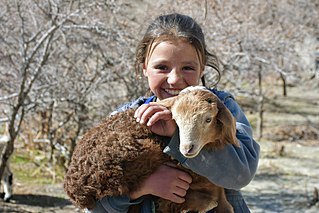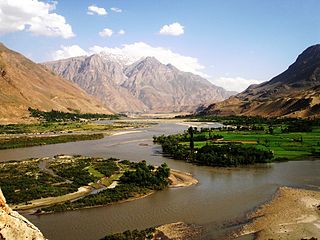Related Research Articles

The Demographics of Tajikistan is about the demography of the population of Tajikistan, including population growth, population density, ethnicity, education level, health, economic status, religious affiliations, and other aspects of the population.

Tajiks are a Persian-speaking Iranian ethnic group native to Central Asia, living primarily in Afghanistan, Tajikistan, and Uzbekistan. Tajiks are the largest ethnicity in Tajikistan, and the second-largest in Afghanistan and Uzbekistan. They speak varieties of Persian, a Western Iranian language. In Tajikistan, since the 1939 Soviet census, its small Pamiri and Yaghnobi ethnic groups are included as Tajiks. In China, the term is used to refer to its Pamiri ethnic groups, the Tajiks of Xinjiang, who speak the Eastern Iranian Pamiri languages. In Afghanistan, the Pamiris are counted as a separate ethnic group.

Badakhshan is a historical region comprising parts of modern-day north-eastern Afghanistan, eastern Tajikistan, and Taxkorgan Tajik Autonomous County in China. Badakhshan Province is one of the 34 provinces of Afghanistan. Much of historic Badakhshan lies within Tajikistan's Gorno-Badakhshan Autonomous Region in the southeastern part of the country. The music of Badakhshan is an important part of the region's cultural heritage.

Gorno-Badakhshan, officially the Badakhshan Mountainous Autonomous Region, is an autonomous region in eastern Tajikistan, in the Pamir Mountains. It makes up nearly forty-five percent of the country's land area but only two percent of its population.

The Wakhi people, also locally referred to as the Wokhik, are an Iranian ethnic group native to Central and South Asia. They are found in Afghanistan, Tajikistan, Pakistan and China—primarily situated in and around Afghanistan's Wakhan Corridor, the northernmost part of Pakistan's Gilgit−Baltistan and Chitral, Tajikistan's Gorno−Badakhshan Autonomous Region and the southwestern areas of China's Xinjiang Uyghur Autonomous Region. The Wakhi people are native speakers of the Wakhi language, an Eastern Iranian language.

The Tajikistani Civil War, also known as the Tajik Civil War, began in May 1992 and ended in June 1997. Regional groups from the Garm and Gorno-Badakhshan regions of Tajikistan rose up against the newly-formed government of President Rahmon Nabiyev, which was dominated by people from the Khujand and Kulob regions. The rebel groups were led by a combination of liberal democratic reformers and Islamists, who would later organize under the banner of the United Tajik Opposition. The government was supported by Russian military and border guards.

Darvaz, alternatively Darwaz, Darvoz, or Darwoz, was an independent Pamiri principality until 1878, ruled by a Mir and its capital was at Qal'ai Khumb. The principality controlled territory on the left and right banks of the Oxus River. The major towns were Qal'ai Khumb and Kham.

Shighnan, also Shignan, Shugnan, Shughnan, and Khughnan, is an historic region whose name today may also refer to a town and a district in Badakhshan Province in the mountainous northeast of Afghanistan and also a district in Gorno-Badakhshan Autonomous Province in Tajikistan. The administrative center of the Shighnan District of Afghanistan is called Qaleh Barpanjeh. The administrative center of the Shughnon District of Tajikistan is called Khorogh.

The Pamiris are an Eastern Iranian ethnic group, native to Central Asia, living primarily in Tajikistan (Gorno-Badakhshan), Afghanistan (Badakhshan), Pakistan (Gilgit-Baltistan) and China.
Badakhshani' or Badakhshi may refer to:

Rushani is one of the Pamir languages spoken in Afghanistan and Tajikistan. Rushani is relatively closer to all Northern Pamiri languages sub-group whether it is Shughni, Yazgulami, Sarikuli or Oroshori sharing many grammatical and vocabulary similarity with all of them especially with Shughni and thus some linguists consider it a dialect of Shughni.

Murghob District is a district in Tajikistan, occupying the eastern two-thirds of the Gorno-Badakhshan Autonomous Region (GBAO). The area of Murghob District is 37,300 km2, covering 26 percent of Tajikistan's soil, but only 0.17% of its population. Murghob District borders on Kyrgyzstan to the north, China to the east, and Afghanistan to the south. The population of Murghob District is 15,900. Its administrative capital is the village Murghob.

Lal'i Badakhshan is an opposition political party in Tajikistan. The party was formed by Pamiri people for the purpose of protecting the rights of Pamiris and promoting the autonomy of the Gorno-Badakhshan Autonomous Province.
Rushon is a town and the seat of Rushon District of Gorno-Badakhshan Autonomous Region in southeastern Tajikistan. The town with aglomeration has a total population of 6,577 (2015).
The Badzhui (Bajuwi) are a subgroup of the Shughni group of Pamiris, although sometimes considered to be a distinct ethnographic group. They are primarily Sunni Muslim, unlike the Shughni who are Ismaili. The Badzhui are also known under the generic term Pamir people. They live in the Rushon District of the Gorno-Badakhshan Autonomous Region, Tajikistan.
Abusaid Shokhumorov (1955–1999) was a famous Pamiri, Tajik scholar in the history and philosophy of Pamiri Ismailism.
Oroshori is a dialect of Shughni, a Pamiri language spoken in the Gorno-Badakhshan Autonomous Region in Tajikistan as well as 267 speakers in Afghanistan's Badakhshan Province. It is similar to other dialects of Shughni such as Rushani and Bartangi. Oroshori contains many loanwords from Sarikoli as well as Kyrgyz.

Tolibbek Ayyombekov, commonly known as Tolib Ayombekov, is an Ismaili Shia Pamiri jailed ex-opposition fighter from Tajikistan, who was involved in the Gorno-Badakhshan clashes in 2012 against the government forces of ruling Tajik president Emomali Rahmon. Until his arrest in June 2022, he was particularly influential in his home Khlebzavod microraion of Khorog.
Yodgor Doyorovich Fayzov is the governor of Tajikistan's southeastern Gorno-Badakhshan Autonomous Region (GBAR). Prior to that he was head of the Aga Khan Foundation office in Tajikistan. Fayzov replaced Shodikhon Jamshed as governor on 1 October 2018, by executive order of Tajik President Emomali Rahmon following civil unrest in the region.
The Shughni are an Iranian sub-ethnic group of Pamiris, who reside in the Pamir Mountains of the Badakhshan region of Central Asia. They mostly live in the country of Tajikistan, while a minority lives in Afghanistan, Pakistan, and China. They speak the Shughni language, an Eastern Iranian language of the Pamiri subgroup.
References
- ↑ "Tajikistan". U.S. Department of State. Retrieved 2023-09-01.